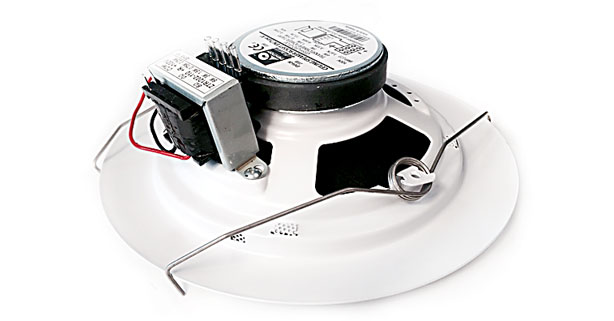In a typical system design, we select the appropriate speakers for the location(s), use the lowest wattage tappings available to produce a satisfactory level and choose an amplifier with sufficient power to meet our requirements plus some reserve.
As an example, a typical ceiling speaker will have a maximum wattage of 6 watts, however in a typical small office with one or two occupants with a low ambient noise level, it is likely that the power requirement will only need to be in the region of 0.5 to 0.75 watts to provide a comfortable level.
This means that it may be possible to use a smaller amplifier than first realised. e.g. in a simple office system with 20 ceiling speakers, normal convention would assume:
20 speakers rated at 6w each = 120 watts without 20% headroom = 144 watts
(Amplifier size required typically 150 – 240 watt depending upon manufacturer)
However, as most ceiling speakers produce approximately 90dB with 1 watt of power, we can afford to reduce the tappings on each speaker to say 1.5 watts and reduce the amplifier size as follows:
20 speakers set at 1.5w each = 30 watts without 20% headroom = 36 watts
(Amplifier size required typically 50-60 watt depending upon manufacturer)
 In noisier environments with higher background sound, there may be a point where we have to choose speakers with higher power ratings and greater sensitivity (i.e. more dB output per watt). Speaker mounting locations also vary from site to site which requires calculations for loss over distance. (See loss calculator here)
In noisier environments with higher background sound, there may be a point where we have to choose speakers with higher power ratings and greater sensitivity (i.e. more dB output per watt). Speaker mounting locations also vary from site to site which requires calculations for loss over distance. (See loss calculator here)
In larger spaces such as factories and plant areas where sound levels are often 75-85 dBA, careful choice of speaker is required to ensure the broadcast level in the listening area is of a satisfactory level.
Projection, music horn and reflex horn speakers all offer possible solutions to these sorts of areas.
Example – a factory with production noise levels constant in the 80dBA range.
Listener needs approximately 90dBA for sufficient headroom above background noise.
Distance for speaker to listener is 10 metres which equates to 20dB loss.
Loudspeaker needs to produce 90+20 = 110dB to meet the requirement.
Solution is to source a speaker with sufficient sensitivity and power to produce 110dB such as a music or reflex horn.
As a rule SPEAKERS COME SET TO THEIR MAXIMUM SETTINGS and often these want reducing prior to installation. Saving a few watts here and there always helps!



